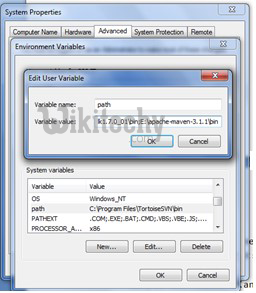

- #MAVEN INSTALL TUTORIAL HOW TO#
- #MAVEN INSTALL TUTORIAL UPGRADE#
- #MAVEN INSTALL TUTORIAL SOFTWARE#
- #MAVEN INSTALL TUTORIAL DOWNLOAD#

Type - 'View Adva' in the search option and we will see the option - View Advanced system setting. 3) We need to configure MAVENHOME environment variable. We dont need to install anything, just unzip the folder.

We will also cover some very basic concepts in databases. In this tutorial, we will learn about Maven, a tool for dependency management.
#MAVEN INSTALL TUTORIAL SOFTWARE#
Installing this plug-in is easy and would take only around 5-10 minutes. Lehigh University Software Engineering Tutorial Series Maven and Databases. NOTES: Eclipse Kepler (4.3) and newer versions already have Maven integration so you don’t need to install the plug-in for this version of Eclipse.The most popular Maven plug-in for Eclipse Java EE IDE is called Maven Integration for WTP (m2e-wtp).
#MAVEN INSTALL TUTORIAL HOW TO#
On the other hand, a parent project may also aggregate projects that do not inherit from it.This tutorial presents a step-by-step guide about how to install Maven plugin (m2e) for an existing Eclipse version (Juno 4.2 and older). and illustrates some of the differences between using Ant and Maven to develop NetBeans Platform applications.After you understand how Maven is different from Ant, you can easily proceed through other tutorials on the NetBeans Platform Learning Trail. Please note that while child modules inherit from their parent project, a parent project does not necessarily have any modules that it aggregates. This document is based on the Ant-based NetBeans Platform Quick Start for NetBeans Platform. Moreover, you can provide exclusions for dependency management in parent's pom.xml, so that specific libraries will not be inherited by child modules: įinally, if a child module needs to use a different version of a managed dependency, you can override the managed version in child's pom.xml file: Let's take a look at a sample parent's pom.xml: īy declaring the spring-core version in the parent, all submodules that depend on spring-core can declare the dependency using only the groupId and artifactId, and the version will be inherited: This will simplify the references to the artifacts in the child POMs. When you have a set of projects or modules that inherit a common parent, you can put all the required information about the dependencies in the common pom.xml file. mvn install:install-file -Dfilejar-file-path> -DartifactIdfeature -Dversionversion -Dpackagingpackaging -DgeneratePomtrue -DcreateChecksumtrue. This is easy and simple way to install jar from local repository or path of jar file.

Step 3: Create environment variable for MAVENHOME. If all goes well, you should be presented with some information about the Maven installation. Step 2: Unzip the folder and save it on the local disk. To test the Maven installation, run mvn from the command-line: mvn -v.
#MAVEN INSTALL TUTORIAL DOWNLOAD#
Maven Setup: Step 1: To setup Maven, download the maven’s latest version form Apache depending upon different OS. Properties are also often used to define build path variables: ĭependency management is a mechanism for centralizing the dependency information for a muti-module parent project and its children. install-file goal is a maven commands used to install local jar files. install: install the package into the local repository for use of another project.
#MAVEN INSTALL TUTORIAL UPGRADE#
Now if you want to upgrade Spring to a newer version, you only have to change the value inside the property tag and all the dependencies using that property in their tags will be updated. Maven properties are value-placeholders and are accessible anywhere within a pom.xml by using the notation $, where name is the property. In the classic use case, you would use custom properties to define versions for your project's dependencies. mvn compile: This command is used to compile the source. Also, this ensures that the build target is being removed for a new build and adds the clean target. This build life cycles may have its build phases and inside each build, there are different build goals. Custom properties can help to make your pom.xml file easier to read and maintain. mvn clean install: This maven command helps in executing a clean build life cycle and installs build phase in the default build cycle.


 0 kommentar(er)
0 kommentar(er)
